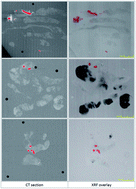The presence of calcifications is an early indicator of breast cancer and is detected using a mammography to diagnose the disease. However, both malignant and benign tissues present these calcifications, and the small chemical differences in both cases have been difficult to distinguish. Vibrational spectroscopy has been used to study these differences, but the difficulty arises in trying to locate them deep in tissue.
Researchers in the UK at Gloucestershire Royal Hospital, Cranfield University and the University of Exeter compared micro CT and X-ray fluorescence (XRF) in locating calcifications embedded within wax biopsy tissue samples. Both techniques successfully located calcifications, and CT had some advantages in resolution, speed and depth. Furthermore, typical collection, such as the dyes used in histological staining can affect the collected spectra. An alternative method such as CT coupled with spectroscopy could potentially find calcifications and detect cancer.
To read more about this study, click the link below which is free until April 19th.
Locating microcalcifications in breast histopathology sections using micro CT and XRF mapping
Robert Scott, Catherine Kendall, Nicholas Stone and Keith Rogers
Anal. Methods, 2014, Advance Article
DOI: 10.1039/C3AY42158A











